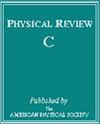Machine learning study to identify collective flow in small and large colliding systems
IF 3.4
2区 物理与天体物理
Q1 Physics and Astronomy
引用次数: 0
Abstract
Collective flow has been found to be similar between small colliding systems ( and collisions) and large colliding systems (peripheral collisions) at the CERN Large Hadron Collider. In order to study the differences of collective flow between small and large colliding systems, we employ a point-cloud network to identify Pb collisions and peripheral Pb Pb collisions at TeV generated from a multiphase transport model. After removing the discrepancies in the pseudorapidity distribution and the spectra, we capture the discrepancy in collective flow. Although the verification accuracy of our PCN is limited due to similar event-by-event distributions of elliptic and triangular flow, we demonstrate that collective flow between Pb collisions and peripheral Pb Pb collisions becomes more distinct with increasing final hadron multiplicity and parton scattering cross section. This study not only highlights the potential of PCN techniques in advancing the understanding of collective flow in varying colliding systems, but more importantly lays the groundwork for the future PCN-related research.

识别小型和大型碰撞系统中集体流的机器学习研究
在欧洲核子研究中心的大型强子对撞机上,小型对撞系统(p+p 和 p+A 对撞)和大型对撞系统(外围 A+A 对撞)之间的集体流是相似的。为了研究小型对撞系统和大型对撞系统之间集体流的差异,我们采用了一个点云网络来识别由多相输运模型生成的 sNN=5.02 TeV 的 p+ Pb 对撞和外围 Pb + Pb 对撞。在剔除了伪电容分布和 pT 谱的差异之后,我们捕捉到了集体流的差异。尽管由于椭圆流和三角流的事件分布相似,我们的PCN的验证精度受到了限制,但我们证明了随着最终强子倍率和粒子散射截面的增加,p+ Pb对撞和外围Pb + Pb对撞之间的集体流变得更加明显。这项研究不仅凸显了 PCN 技术在推进对不同对撞系统中集体流的理解方面的潜力,更重要的是为未来 PCN 相关研究奠定了基础。
本文章由计算机程序翻译,如有差异,请以英文原文为准。
求助全文
约1分钟内获得全文
求助全文
来源期刊

Physical Review C
物理-物理:核物理
CiteScore
5.70
自引率
35.50%
发文量
0
审稿时长
1-2 weeks
期刊介绍:
Physical Review C (PRC) is a leading journal in theoretical and experimental nuclear physics, publishing more than two-thirds of the research literature in the field.
PRC covers experimental and theoretical results in all aspects of nuclear physics, including:
Nucleon-nucleon interaction, few-body systems
Nuclear structure
Nuclear reactions
Relativistic nuclear collisions
Hadronic physics and QCD
Electroweak interaction, symmetries
Nuclear astrophysics
 求助内容:
求助内容: 应助结果提醒方式:
应助结果提醒方式:


